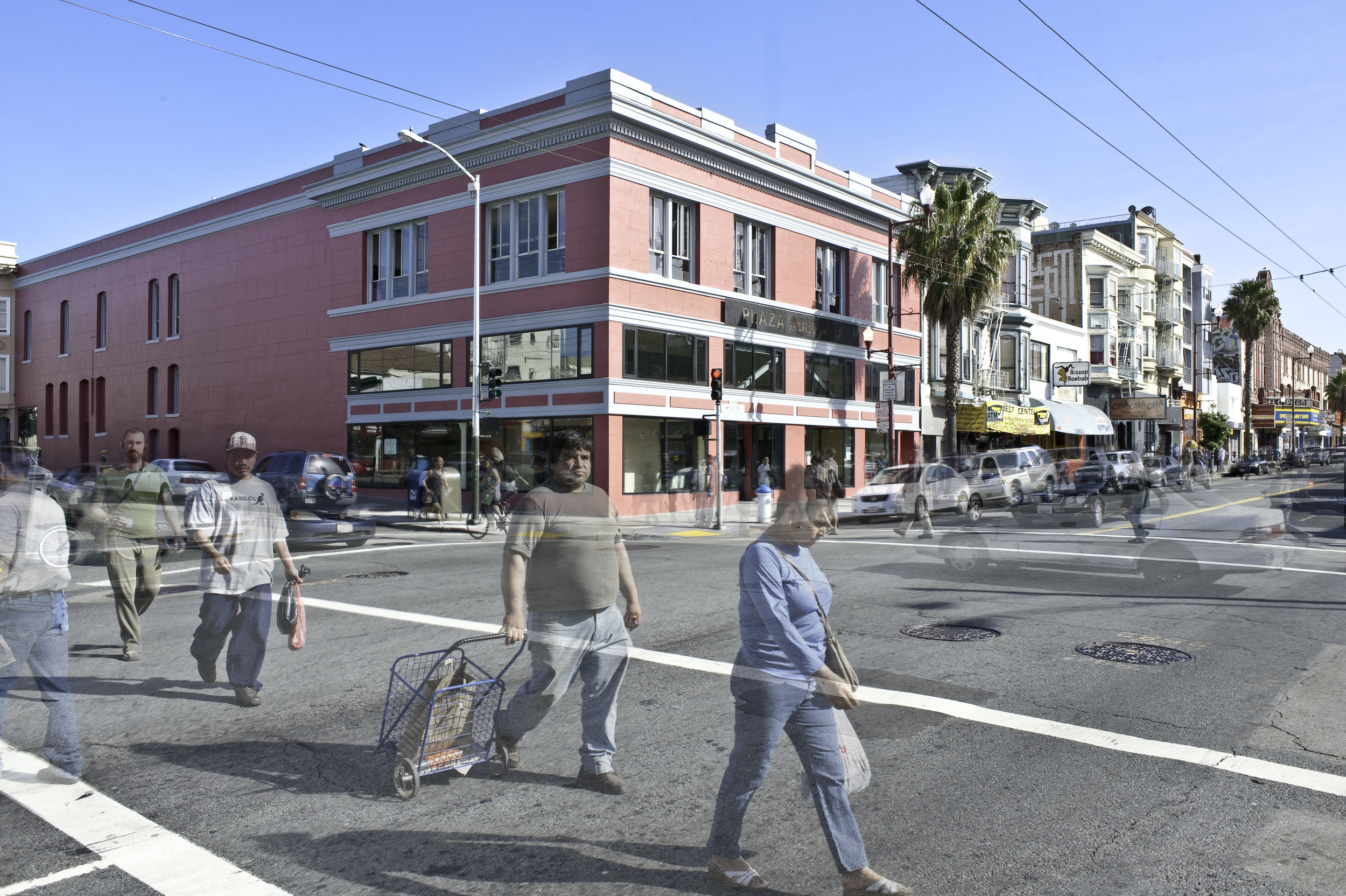Sandra I. Vivanco
Emblematic of the commerce and entertainment activity that is the heart and soul of the Latino neighborhood of San Francisco, a jewel-toned building stands proud and calm in harsh distinction to the uproar of Mission and Twentieth streets. Due to its unlikely location in what has become the hottest neighborhood in the most expensive city in the United States, this immigrant resource center is at once meeting place, refuge, and locus of resistance.
On a winter afternoon not long ago, a Nicaraguan couple recently evicted from their apartment commiserated with a single mother looking to place her infant in affordable childcare because she is reentering full-time employment. Nearby, a Venezuelan refugee sought legal advice while a small business entrepreneurship class took place in the adjacent classroom. In our current political climate, these all-too-common scenarios represent a significant challenge for both immigrants and laborers in the Bay Area.
The Client
The project was developed by Mission Economic Development Association (MEDA), a community-based organization with a mission to strengthen low- and moderate-income Latino families by promoting economic equity and social justice through asset building and community development. MEDA envisions generations of Latino families that have sufficient assets to thrive; that are rooted in vibrant, diverse, and forward-thinking communities; and that are actively engaged in the civic and political life of their neighborhoods and the institutions that affect their lives.
For years, MEDA has prioritized service integration across the agency as it increases the success rate of their clients by coordinating all of the programs they access. In addition, financial capability is fully integrated into all of their services, as research has shown that clients are three times more likely to improve their credit, savings, income, or debt if they participate in multiple asset development services. Every family at MEDA receives financial coaching and screening for public benefits while accessing multiple services within the agency.
While promoting economic empowerment for the Latino immigrant population, MEDA provides a host of services to reach financial stability ranging from housing assistance to small business incubators and from digital literacy to job training. Sharing the facilities are many other nonprofit organizations promoting community real estate, housing opportunities, financial capability, free tax preparation, business development, community loan funds, workforce development, and opportunities to bridge the technology and digital divide.
The Project
Plaza Adelante consolidates multiple nonprofit organizations, previously dispersed in different areas of San Francisco, into a single location anchored in the bustling heart of the Mission District. Inspired by the high level of interaction between these organizations, A+D decided to explore new spatial paradigms to promote and foster further connections and future interactions.
The project relied on funding that was only available between 2008–10, and as a result the entire project team worked tirelessly to obtain government approvals and complete construction on an unrelenting schedule that went from ideation to building in a fraction of the time a project of this complexity would have usually taken.
We transformed an existing family-owned, three-story furniture store into a community center by overlapping multifunctional spaces to merge the collective with the semipublic areas of the individual organizations headquartered there. We cut deep light wells and choreographed a clear but complex circulation system that celebrated chance encounters and encouraged public interaction by using transparency. A couple of years later, in collaboration with the CCA BuildLab students, we designed and built nine different furniture-scale architectural interventions that addressed the boundaries between the diverse services offered at Plaza Adelante while actively bringing the vibrancy of the street into the bowels of our project.
We make more with less. We exposed all of the possible social spaces to the common circulation and opened class and conference rooms by glazing them so that from every floor one is aware of the activities taking place in the adjacent space. We hoped to build community by allowing each individual to feel part of the whole and encouraging interaction within strangers.
We work simultaneously at the scale of the city and the body. We created a generous entry space, the Paseo, as a third kind of space that is both intimate and communal. Intuitive and synthetic, the scissoring canopies of the café mediated between the silence of offices, classrooms, and the raucous street activity.
We discover innovation through analyzing complexity. At Plaza Adelante, we worked simultaneously at many levels beyond the traditional roles of artist and architect—we helped fundraise, we advocated for MEDA’s clients, we brokered relationships between government and nonprofit agencies, we design-built, and we shaped cultural memory into collective space.
The Architect
Characterized by the investigation of cultural and technological aspects of modern city inhabitation, our practice is solidly rooted in the industry of construction and design and within the academic dialogue of architecture. Such a balance affords the professional ventures of the firm to tap the unfettered ideas of academia. Processing these recent contemporary developments in architecture with a skillful eye for construction and affordability promotes innovation and has repeatedly drawn attention and accolades to our work.
Our studio has a long, successful history of design collaborations. An architectural project is strengthened when complimentary talents, experience, and approaches are consolidated into one single effort—to design and build an innovative, environmentally conscious building in direct response to its urban and social context. Our design practice brings together four different scales of architectural interest: culturally diverse architectural history, urban and landscape design, interior architecture, and environmentally aware component fabrication.
The variety of roles we are prepared to undertake allows us to intervene meaningfully in the public realm. With multiple operations of urban acupuncture, we energize the urban realm and in the process highlight formerly invisible, underserved communities. These conditions frame our obsession with the place the individual occupies in the city which by definition is a negotiated realm.
We are new but have a long memory.
We are local but nonnative.
We are small but think BIG.

